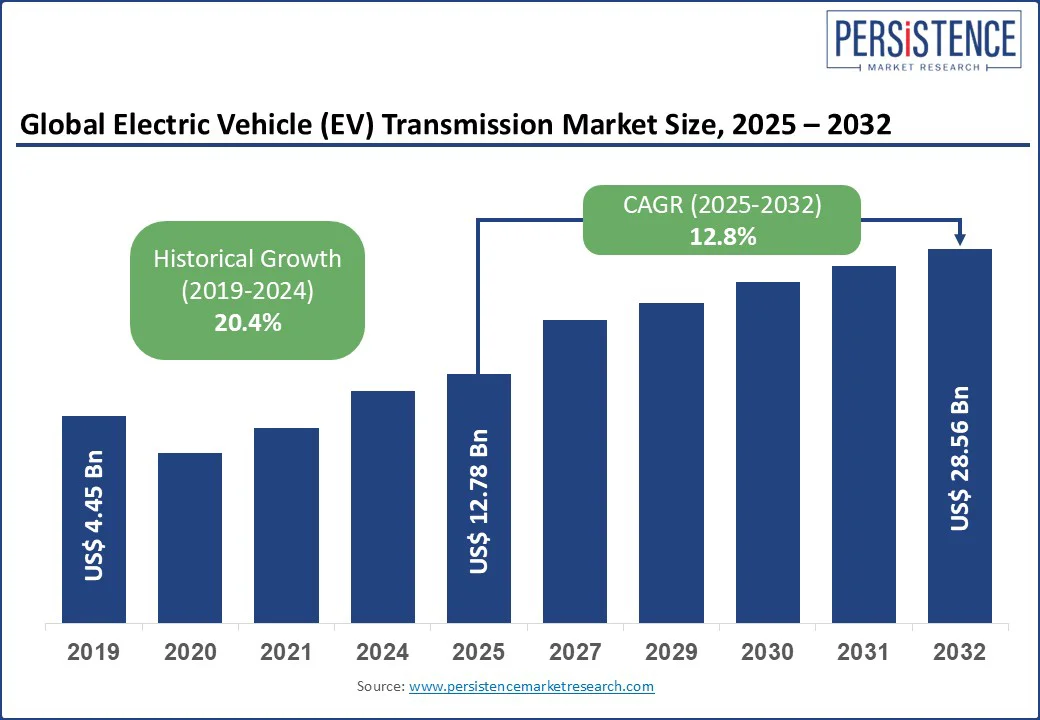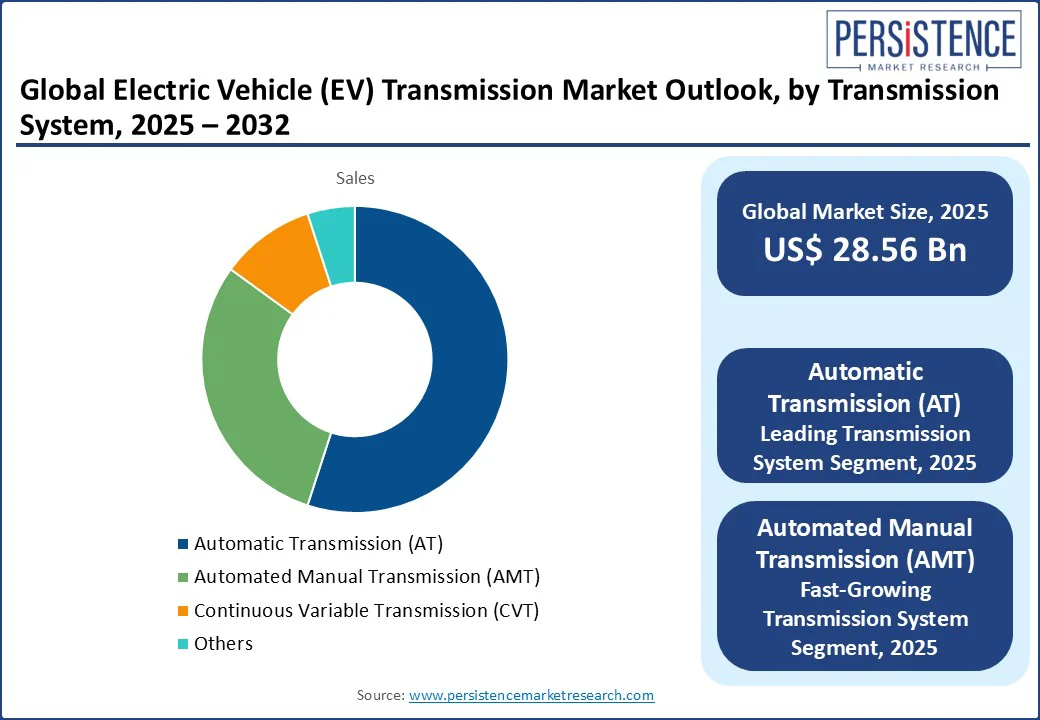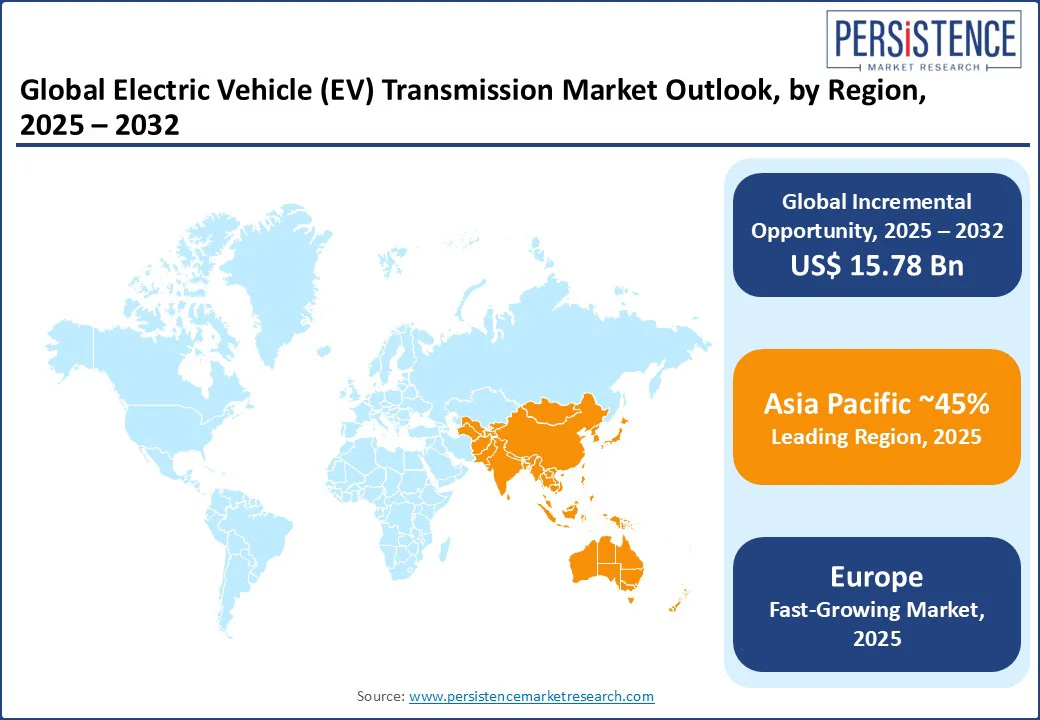ID: PMRREP35568| 188 Pages | 18 Aug 2025 | Format: PDF, Excel, PPT* | Automotive & Transportation

The global electric vehicle (EV) transmission market size is likely to be valued at US$ 12.78 Bn in 2025, and is estimated to reach US$ 28.56 Bn by 2032, growing at a CAGR of 12.8% during the forecast period 2025 to 2032.
The rising adoption of multi-speed transmissions in heavy-duty electric vehicles (EVs) and the integration of e-axles and Transmission Control Units (TCUs) by original equipment manufacturers (OEMs) are the two major growth determinants.
Electric vehicle (EV) transmissions are the critical drivetrain component that translates electric motor torque into optimized wheel performance across various EV types. With drivetrain innovation forming the core engine of advancement for electric mobility, the market for EV transmissions stands at the precipice of enormous expansion due to tightening regulations to curb tailpipe emissions, widespread electrification of commercial fleets, and the urgent requirement for high-efficiency torque conversion.
Intelligent gearboxes capable of real-time power management are finding momentum, especially in fleet and commercial EVs. Some of the most lucrative opportunities in the market are emerging in niche areas such as grid-capable transmission systems aligned with vehicle-to-grid (V2G) technology. These developments are transforming the EV transmission landscape into a strategic focal point for innovation, efficiency, and scalable electrification.

Key Industry Highlights:
|
Global Market Attribute |
Key Insights |
|
EV Transmission Market Size (2025E) |
US$ 12.78 Bn |
|
Market Value Forecast (2032F) |
US$ 28.56 Bn |
|
Projected Growth (CAGR 2025 to 2032) |
12.8% |
|
Historical Market Growth (CAGR 2019 to 2024) |
20.4% |
Given the exigency for developing advanced drivetrain solutions for EVs in the face of climate change challenges, the electric vehicle transmission market growth is likely to be upped by the high demand for performance and range efficiency of commercial EV fleets. While passenger EVs can function smoothly with single-speed gearboxes, electric light- and heavy-duty commercial vehicles require multi-speed EV transmissions to handle varying payloads, gradients, and duty cycles without compromising battery range or thermal stability.
This engineering marvel is influencing procurement decisions across OEMs and tier-1 suppliers, which is particularly significant since fleet electrification is scaling rapidly across major economies.
The integration of transmission hardware with advanced control software, particularly in multi-speed and e-axle architectures, is a process that is rife with complexities. As EV powertrains evolve from mechanical systems into software-defined platforms, transmission modules must now synchronize seamlessly with motor control units (MCUs), automotive battery management systems (BMS), and vehicle dynamics controllers.
Consequently, the mass adoption of multi-speed EV gearbox technologies is becoming increasingly difficult, especially for mid-market BEVs, where cost, system validation, and software support remain unresolved.
The electric vehicle transmission market is replete with opportunities, but one area that promises exceptional returns for EV companies is located in the rapid adoption of integrated e-axle systems. These systems unify the motor, inverter, and transmission into a single compact unit, drastically improving packaging efficiency, energy density, and vehicle performance.
Today, a central concern for EV manufacturers is to reduce vehicle weight and complexity while boosting range. The incorporation of e-axle EVs is emerging as a technically and financially feasible solution, especially in SUVs and crossovers where space constraints and torque demands intersect.
Among transmission systems, the automatic transmission (AT) sub-segment is estimated to account for a leading 55% revenue share in 2025. OEMs are visibly favoring automatic EV gearboxes that deliver seamless torque delivery with minimal mechanical complexity, which is a defining feature for battery electric vehicles.
On the other hand, automated manual transmission systems are set to exhibit the highest CAGR by 2032. The upsurge of AMT systems reflects the deepening interest in dual-clutch and dual-speed automated gearboxes in light- and heavy-duty EVs where efficiency and torque modulation are imperative, especially in logistics fleets and long-haul electric trucks.
Recent OEM innovations, such as Allison’s introduction of the Egan Power 85S e-axle featuring an automated dual-speed gearbox at Bus World Europe in 2023, are testament to the traction smart transmission systems are gathering in commercial applications. Stakeholders seeking to minimize the total cost of ownership (TCO) and thermal efficiency are increasingly embracing multi-speed AMT models, especially in regions where range and payload flexibility are non-negotiable.
Battery electric vehicles are slated to be the dominant sub-segment, projected to account for nearly 90% share in 2025. The enviable position of BEVs in the EV transmission market is because of their minimal reliance on plug-in hybrid or hybrid powertrains, allowing streamlined integration of single-speed EV gearboxes, direct-drive transmission systems, and a much simplified architecture. For example, renowned BEV platforms such as China’s BYD Seal and Tesla Model 3 depend on single-ratio or single-speed reduction gearboxes, enabling lower costs and easier thermal management in modular EV architectures. The demand for direct drive transmission and automatic transmission systems in BEVs unlikely to dampen as OEMs are expected to continue to scale mass-market offerings.
Even though the revenue share of plug-in hybrid electric vehicles is considerably than BEVs, this sub-segment is nonetheless anticipated to grow at the fastest CAGR through 2032. PHEVs are gaining prominence in markets where range anxiety is still a concern but infrastructure is nascent. These vehicles necessitate the utilization of dual-mode transmission systems that can facilitate hassle-free switching between electric single-speed direct drive and conventional combustion transmission. OEMs are actively tapping into the PHEV space with new releases such as Volvo’s XC60 Recharge PHEV and Mitsubishi Outlander PHEV that are armed with adaptive transmission modules designed for both EV torque characteristics and internal combustion engine (ICE) coupling.

At 45%, Asia Pacific accounts for the largest portion of the electric vehicle transmission market share, convincingly led by China’s command over EV production, sales, and exports. In 2024, according to the International Energy Agency (IEA), more than 11 million electric cars were sold in China. The regional market also accrues benefits from the vertically integrated EV supply chains, such as the battery-to-transmission structure, highly attractive government incentives promoting EV adoption (such as India’s FAME scheme), and OEMs such as SAIC and JATCO investing heavily in transmission R&D. As an outcome an intricate ecosystem is available for single-speed EV gearboxes, multi-speed transmission systems, and e-axle integration tailored for modular BEV platforms. Across the major economies of the region, government policies and corporate strategies are oriented towards making EV adoption affordable for the average consumer, encouraging fleet electrification of buses and trucks, and setting practical national targets on emissions and mobility.
North America commands roughly 41% share of the EV transmission systems market, attributable to the drivetrain advancements spearheaded by Tesla, GM, Ford, and Rivian, and strong public and private investments in scaling EV charging infrastructure and R&D activities in cutting-edge transmission technologies. Despite the winding down of the U.S. federal tax credit for EV makers, innovation in transmission systems remains well-received by investors.
Europe, representing a 14% share in 2025, is set to be the fastest-growing regional market of electric vehicle transmission systems during the forecast period 2025-2032. The market is fueled by uncompromising vehicular emissions mandates by the European Union (EU), expansion of zero-emission zones across the continent, and looming bans on ICE sales in Norway, the U.K., and Germany. European OEMs, such as Volkswagen, Mercedes Benz, and BMW, are speedily pivoting to modular EV platforms with integrated transmissions and e-axles, often embedding multi-speed systems for performance and efficiency. Moreover, the regulatory push for reducing carbon emissions is stimulating demand for energy-optimizing transmissions in passenger BEVs and plug-in commercial fleets.

With the rush for efficient and clean mobility gaining pace worldwide, the global EV transmission market landscape is undergoing a transformative phase, driven by an accelerated convergence of drivetrain innovation, supply-chain control, and system-level differentiation. At the strategic core is the relentless pursuit of the integration of transmission hardware with electrified propulsion systems that will empower suppliers and OEMs to deliver compact, high-efficiency e-axle units and multi-speed gearbox modules.
Top firms such as ZF, Eaton, and Continental are in an overdrive mode to incorporate software-defined transmission control, optimized thermal management, and materials-engineered lightweight casings to reduce cost and improve performance of their products. For example, ZF Friedrichshafen’s modular multi-speed unit and Eaton’s record-level production orders are expected to buttress supplier confidence in transmission systems as a value-added, margin-rich domain. At the same time, industry consolidation through alliances and M&A activities is synergizing R&D operations on adaptive transmission control units integrated with motor inversion systems.
The global electric vehicle (EV) transmission market is projected to reach US$ 12.78 Bn in 2025.
Tightening regulations to curb tailpipe emissions and widespread electrification of commercial fleets are driving growth.
The market is poised to witness a CAGR of 12.8% from 2025 to 2032.
The increasing urgency for high-efficiency torque conversion in EVs and the development of intelligent gearboxes capable of real-time power management are key market opportunities.
ZF Friedrichshafen AG, Eaton Corporation plc, and Continental AG are a few leading market players.
|
Report Attribute |
Details |
|
Historical Data/Actuals |
2019 - 2024 |
|
Forecast Period |
2025 - 2032 |
|
Market Analysis |
Value: US$ Bn/Mn, Volume: As Applicable |
|
Geographical Coverage |
|
|
Segmental Coverage |
|
|
Competitive Analysis |
|
|
Report Highlights |
|
|
Customization and Pricing |
Available upon request |
By Transmission Type
By Transmission System
By Vehicle Type
By Region
Delivery Timelines
For more information on this report and its delivery timelines please get in touch with our sales team.
About Author